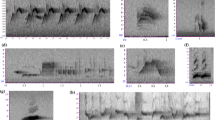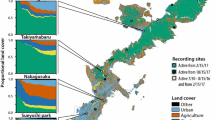Abstract
We determined the relationship between acoustic diversity and metrics of vertical forest structure derived from light detection and ranging (LIDAR) data in a neotropical rainforest in Costa Rica. We then used the LIDAR-derived metrics to predict acoustic diversity across the forest landscape. Sound recordings were obtained from 14 sites for six consecutive days during dusk chorus (6 pm). Acoustic diversity was calculated for each day as the total intensity across acoustic frequency bands using the Shannon index and then averaged over the 6 days at each site. A 10 m radius around each site was used to obtain several LIDAR-derived metrics describing the vertical structural attributes of the forest canopy. Multiple linear regression (MLR) with Akaike information criterion was used to determine a top-ranked model with acoustic diversity as the dependent variable and the LIDAR metrics as independent variables. Acoustic diversity was modeled for forested areas (where canopy height was >20 m) at 20 m resolution using coefficients obtained from the MLR, and a hotspot analysis was conducted on the resulting layer. Acoustic diversity was strongly correlated (R 2 = 0.75) with the LIDAR metrics suggesting that LIDAR-derived metrics can be used to determine canopy structural attributes important to vocal fauna species. The hotspot analysis revealed that the spatial distribution of these canopy structural attributes across the La Selva forest is not random. Our approach can be used to identify forest patches of potentially high acoustic diversity for conservation or management purposes.




Similar content being viewed by others
References
Anselin L (1995) Local indicators of spatial association—LISA. Geogr Anal 27:93–115
Burnham KP, Anderson DR (2004) Multimodel inference: understanding AIC and BIC in model selection. Sociol Methods Res 33:261–304
Clawges R, Vierling K, Vierling L, Rowell E (2008) The use of airborne lidar to assess avian species diversity, density, and occurrence in a pine/aspen forest. Remote Sens Environ 112:2064–2073
Depraetere M, Pavoine S, Jiguet F, Gasc A, Duvail S, Sueur J (2012) Monitoring animal diversity using acoustic indices: implementation in a temperate woodland. Ecol Ind 13:46–54
Diaz I, Armesto J, Reid S, Sieving K, Willson M (2005) Linking forest structure and composition: avian diversity in successional forests of Chiloe Island, Chile. Biol Conserv 123:91–101
Donnelly MA (1994) Amphibian diversity and natural history. In: McDade LA, Bawa KS, Hespenheide HA, Hartshorn GS (eds) La Selva: ecology and natural history of a neotropical rain forest. University of Chicago Press, Chicago, pp 199–209
Drake JB, Dubayah RO, Clark DB, Knox RG, Blair JB, Hofton MA, Chazdon RL, Weishampel JF, Prince S (2002) Estimation of tropical forest structural characteristics using large-footprint lidar. Remote Sens Environ 79:305–319
Duellman WE, Pyles RA (1983) Acoustic resource partitioning in anuran communities. Copeia 1983:639–649
Dumyahn SL, Pijanowski BC (2011) Soundscape conservation. Landscape Ecol 26:1327–1344
ESRI (2010) ArcGIS version 10.0. Environmental Systems Research Institute, Redlands
Farina A, Lattanzi E, Malavasi R, Pieretti N, Piccioli L (2011) Avian soundscapes and cognitive landscapes: theory, application and ecological perspectives. Landscape Ecol 26:1257–1267
Francis CD, Paritsis J, Ortega CP, Cruz A (2011) Landscape patterns of avian habitat use and nest success are affected by chronic gas well compressor noise. Landscape Ecol 26:1269–1280
Gerhardt HC, Huber F (2002) Acoustic communication in insects and anurans. University of Chicago Press, Chicago, p 531
Goetz S, Steinberg D, Dubayah R, Blair B (2007) Laser remote sensing of canopy habitat heterogeneity as a predictor of bird species richness in an eastern temperate forest, USA. Remote Sens Environ 108:254–263
Goetz SJ, Steinberg D, Betts MG, Holmes RT, Doran PJ, Dubayah R, Hofton M (2010) Lidar remote sensing variables predict breeding habitat of a neotropical migrant bird. Ecology 91:1569–1576
Halaj J, Ross DW, Moldenke AR (2000) Importance of habitat structure to the arthropod food-web in Douglas-Fir Canopies. Oikos 90:139–152
Ishii HT, Tanabe S, Hiura T (2004) Exploring the relationships among canopy structure, stand productivity, and biodiversity of temperate forest ecosystems. For Sci 50:342–355
Joo W, Gage SH, Kasten EP (2011) Analysis and interpretation of variability in soundscapes along an urban–rural gradient. Landsc Urban Plan 103:259–276
Jung J, Crawford MM (2012) Extraction of features from LIDAR waveform data for characterizing forest structure. Geosci Remote Sens Lett IEEE 9:492–496
Jung J, Pekin BK, Pijanowski BC (2012) Mapping open space in an old-growth, secondary-growth, and selectively-logged tropical rainforest using discrete return LIDAR. J Sel Top Appl Earth Obs Remote Sens IEEE. doi:10.1111/j.1472-4642.2012.00928.x
Karr JR, Roth RR (1971) Vegetation structure and avian diversity in several new world areas. Am Nat 05:423–435
Kellner JR, Clark DB, Hubbell SP (2009) Pervasive canopy dynamics produce short-term stability in a tropical rain forest landscape. Ecol Lett 12:155–164
Krause B, Gage SH, Joo W (2011) Measuring and interpreting the temporal variability in the soundscape at four places in Sequoia National Park. Landscape Ecol 26:1247–1256
Lefsky MA, Cohen WB, Parker GG, Harding DJ (2002) Lidar remote sensing for ecosystem studies. Bioscience 52:19–30
Levey DJ, Stiles FG (1994) Birds: ecology, behavior, and taxonomic affinities. In: McDade LA, Bawa KS, Hespenheide HA, Hartshorn GS (eds) La Selva: ecology and natural history of a neotropical rain forest. University of Chicago Press, Chicago, pp 217–228
Lindenmayer DB, Franklin JF, Fischer J (2006) General management principles and a checklist of strategies to guide forest biodiversity conservation. Biol Conserv 131:433–445
MacArthur RH, MacArthur JW (1961) On bird species diversity. Ecology 42:594–598
Matsinos YG, Mazaris AD, Papadimitriou KD, Mniestris A, Hatzigiannidis G, Maioglou D, Pantis JD (2008) Spatio-temporal variability in human and natural sounds in a rural landscape. Landscape Ecol 23:945–959
Mazaris AD, Kallimanis AS, Chatzigianidis G, Papadimitriou K, Pantis JD (2009) Spatiotemporal analysis of an acoustic environment: interactions between landscape features and sounds. Landscape Ecol 24:817–831
McDade LA, Bawa KS, Hespenheide HA, Hartshorn GS (1994) La Selva: ecology and natural history of a neotropical rain forest. University of Chicago Press, Chicago
McElhinny C, Gibbons P, Brack C, Bauhus J (2005) Forest and woodland stand structural complexity: its definition and measurement. For Ecol Manag 218:1–24
Miyamoto MM (1982) Vertical habitat use by Eleutherodactylus frogs (Leptodactylidae) at two Costa Rican localities. Biotropica 14:141–144
Müller J, Brandl R (2009) Assessing biodiversity by remote sensing in mountainous terrain: the potential of LIDAR to predict forest beetle assemblages. J Appl Ecol 46:897–905
Müller J, Moning C, Bässler C, Heurich M, Brandl R (2009) Using airborne laser scanning to model potential abundance and assemblages of forest passerines. Basic Appl Ecol 10:671–681
Müller J, Stadler J, Brandl R (2010) Composition versus physiognomy of vegetation as predictors of bird assemblages: the role of lidar. Remote Sens Environ 114:490–495
Myers N, Mittermeier RA, Mittermeier CG, da Fonseca GA, Kent J (2000) Biodiversity hotspots for conservation priorities. Nature 403:853–858
Oksanen J, Blanchet FG, Kindt R, Legendre P, Minchin PR, O’Hara RB, Simpson GL, Solymos P, Stevens MHH, Wagner H (2012). Vegan: community ecology package. R package version 2.0-3. http://cran.r-project.org/web/packages/vegan/
Olson DM, Dinerstein E (1998) The global 200: representation approach earth’s most biologically valuable ecoregions. Conserv Biol 12:502–515
Parker GG, Harding DJ, Berger ML (2004) A portable LIDAR system for rapid determination of forest canopy structure. J Appl Ecol 41:755–767
Pearman PB (2002) The scale of community structure: habitat variation and avian guilds in tropical forest understory. Ecol Monogr 72:19–39
Pijanowski BC, Farina A, Gage SH, Dumyahn SL, Krause BL (2011a) What is soundscape ecology? An introduction and overview of an emerging new science. Landscape Ecol 26:1213–1232
Pijanowski BC, Villanueva-Rivera LJ, Dumyahn SL, Farina A, Krause BL, Napoletano BM, Gage SH, Pieretti N (2011b) Soundscape ecology: the science of sound in the landscape. Bioscience 61:203–216
R Development Core Team (2009) R: a language and environment for statistical computing. R Foundation for Statistical Computing, Vienna
Sanford RL, Paaby P, Luvall JC, Phillips E (1994) Climate, geomorphology and aquatic systems. In: McDade LA, Bawa KS, Hespenheide HA, Hartshorn GS (eds) La Selva: ecology and natural history of a neotropical rain forest. University of Chicago Press, Chicago, pp 19–33
Stewart MM (1985) Arboreal habitat use and parachuting by a subtropical forest frog. J Herpetol 19:391–401
Sueur J (2002) Cicada acoustic communication: potential sound partitioning in a multispecies community from Mexico. Biol J Linn Soc 75:379–394
Sueur J, Pavoine S, Hamerlynck O, Duvail S (2008) Rapid acoustic survey for biodiversity appraisal. PLoS One 3:e4065
Tanabe S-I, Toda MJ, Vinokurova AV (2001) Tree shape, forest structure and diversity of Drosophilid community: comparison between boreal and temperate birch forests. Ecol Res 16:369–385
Ter Braak CJF (1986) Canonical correspondence analysis: a new eigenvector technique for multivariate direct gradient analysis. Ecology 67:1167–1179
Verschuyl JP, Hansen AJ, McWethy DB, Sallabanks R, Hutto RL (2008) Is the effect of forest structure on bird diversity modified by forest productivity? Ecol Appl 18:1155–1170
Vierling KT, Vierling LA, Gould WA, Martinuzzi S, Clawges RM (2008) Lidar: shedding new light on habitat characterization and modeling. Front Ecol Environ 6:90–98
Villanueva-Rivera LJ, Pijanowski BC, Doucette J, Pekin B (2011) A primer of acoustic analysis for landscape ecologists. Landscape Ecol 26:1233–1246
Werner U, Buszko J (2005) Detecting biodiversity hotspots using species-area and endemics-area relationships: the case of butterflies. Biodivers Conserv 14:1977–1988
Wilkinson GN, Rogers CE (1973) Symbolic descriptions of factorial models for analysis of variance. Appl Stat 22:392–399
Acknowledgments
The acoustic data in this publication were provided by the Tropical Ecology Assessment and Monitoring (TEAM) Network, which is a collaboration between Conservation International, the Missouri Botanical Garden, the Smithsonian Institution, and the Wildlife Conservation Society, partially funded by these institutions, the Gordon and Betty Moore Foundation, and other donors. The authors thank Johanna Hurtado, the manager of Volcan Barva TEAM site, for her contribution to the data collection efforts. The LIDAR data were collected and provided to the TEAM Network of Conservation International by Northrop–Grumman Corporation, through the Global Climate Monitoring Systems and 3001 remote sensing division. We thank Aaron Swanson from Northrop–Grumman Aerospace Systems for providing information regarding the LIDAR data collection and processing. This project was also partially funded by an NSF grant to BCP (III-XT Program), and an OTS travel scholarship and funds from the Department of Education GAANN Program to LJV.
Author information
Authors and Affiliations
Corresponding author
Rights and permissions
About this article
Cite this article
Pekin, B.K., Jung, J., Villanueva-Rivera, L.J. et al. Modeling acoustic diversity using soundscape recordings and LIDAR-derived metrics of vertical forest structure in a neotropical rainforest. Landscape Ecol 27, 1513–1522 (2012). https://doi.org/10.1007/s10980-012-9806-4
Received:
Accepted:
Published:
Issue Date:
DOI: https://doi.org/10.1007/s10980-012-9806-4




